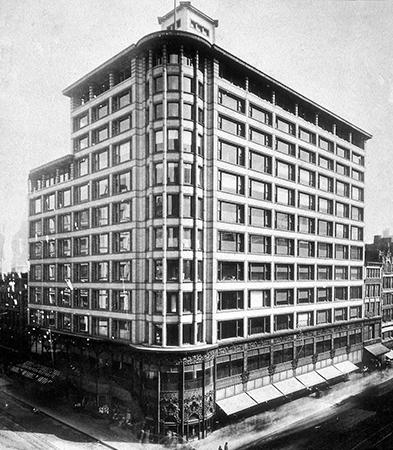By Virginia Garda
At the turn of the twentieth century,
Chicago became the center of a transformation of the urban landscape, most
notably because of the surge of skyscrapers1. The architectural
movement responsible for such innovation was lead by men who were not native to
this city but established their careers in it, and thus they came to be known
as the Chicago School2. The style that they developed was
characterized by an emphasis on both the utilitarian function of buildings and
their aesthetic qualities2, and continued to be influential for
decades throughout the United States1.
The
ingenuity of this group is especially apparent when their architecture is
compared to that of the century preceding it; a series of revivals of older
architectonical styles dominated American architecture throughout the
nineteenth century2, and as a result it was largely derivative and
lacked true originality. Meanwhile, technological developments caused a rapid
development of new forms of civil engineering. Chief among these was the use of
new cast-iron structures to develop arched bridges2. It took a new
generation of bold architects to amend how architectural innovation was
stalling behind engineering and technological inventions.
Chicago
became the ideal gathering place of such a generation because of the
combination several factors. Its population had been growing rapidly since the
1850’s, and the Chicago Fire of 1871 ravaged large portions of the city, which
lead to a high demand for the development of new buildings.2 The
price of land also saw a steep increase2, and thus architects were
obligated to expand vertically instead of horizontally1.
Fortunately, the availability of new technologies such as elevators and the
aforementioned cast-iron structures allowed for the rise of multi-storied buildings1,
and eventually that of the early skyscrapers.
Perhaps
the quintessential architectonical work from this period was the Carson Pirie
Scott Store, which was designed by Louis Sullivan and D.H. Burnham in 18993.
It’s a steel framed building with twelve stories, and features the wide, three
parted windows which came to be known as the Chicago Window3. They
were meant to let in a lot of light into the building, as well as showcase the
merchandise sold by the store. Its exterior was adorned with terra cotta tiles
and bronze decorations, which in addition of being ornamental, were also
practical because of their fire-resistant properties2. This balance between form and function
showcases how Sullivan and his contemporaries were attempting to meet the needs
that modern cities demanded, while continuing to place an importance on the
aesthetic qualities of buildings3.
The
struggle that this generation of architects addressed is not unlike that the
literary modernists faced a couple of decades later. Both movements were caught
in a rapidly-changing world and had to redefine their art forms in order to
address these changes. The modernist authors were writing about urbanization
and urban masses, while the Chicago School had to create a new form of building
in order to solve the problems created by these changes. In addition, while the
literary modernists were attempting to define what the United States
represented through language, the Chicago School managed to create an aesthetic
style that was uniquely American.
It’s
also of interest to talk about the Chicago School in a class about Modernism
because they were responsible for creating the urban landscape that creates the
setting of many of these literary works. Learning about this architectonical style
not only facilitates the visualization of the world these novels were trying to
depict, but also elucidates why the setting of these works was important in the
first place.
Works Cited
[1] "Architecture: The First Chicago
School." Architecture: The First Chicago School. Chicago Historical
Society, 2005. Web. 07 Sept. 2016.
[2] Condit, Carl
W. The Chicago School of Architecture. Chicago: U of Chicago, 1964. Print.
[3] Siry, Joseph. Carson Pirie Scott:
Louis Sullivan and the Chicago Department Store. Chicago: U of Chicago, 1988.
Print.

No comments:
Post a Comment